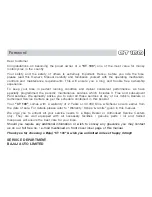
STREET STRATEGIES
This section provides some strategies
to reduce your risk on the road. Many
of these strategies are similar to those
used for motorcycles.
This section is based on guidance for
motorcyclists given by the Motorcy-
cle Safety Foundation (MSF). How-
ever, even experienced motorcyclists
should read this section, as some
strategies are different for the Spyder
roadster.
Plan your Trip
Always check weather conditions be-
fore riding the vehicle. Take appropri-
ate gear for any weather you might
encounter.
Plan a route and ride in conditions that
are appropriate for your skill level.
The vehicle has a 26 L (6.9 U.S. gal.)
fuel tank. When the low fuel indicator
light flashes, fill fuel tank as soon as
possible. Plan your refueling stops,
particularly in unpopulated areas.
Defensive Riding
As with a motorcycle, defensive riding
can help you avoid crashes. You need
to stay alert at all times. Never stop
watching your surroundings, includ-
ing the area behind you. Always scan
for potential hazards, plan ahead, and
leave space and time to avoid trouble.
Do not assume other motorists will
see you or follow the rules of the road.
Following Distance
Always leave at least a two-second fol-
lowing distance between you and the
vehicle in front of you when operat-
ing under ideal riding conditions. This
means that you should pass any fixed
point on the road at least two full sec-
onds after the vehicle in front of you.
When conditions make braking dis-
tance longer, or visibility is limited,
use a longer following distance for a
greater margin of safety. For example,
braking distance is longer on slippery
road surfaces, down hills, or when car-
rying more weight, and visibility may
be limited in fog, in curves or at night.
Scanning Ahead
In addition to leaving adequate follow-
ing distance to the next vehicle, scan
ahead and plan your path even farther
in advance.
Plan your immediate path at least four
seconds ahead. Watch this path for
hazards, such as anything in the road
or anything entering the road.
Scan ahead 12 seconds along your an-
ticipated path to identify potential haz-
ardous situations before they happen.
For example, look for intersections
where other vehicles may appear or
places where pedestrians might enter
the road. Be prepared to respond if a
hazardous situation develops.
Watch Behind and to the Sides
Vehicles and other hazards can ap-
proach from all directions. Constantly
be aware of your surroundings. Check
your mirrors frequently to see directly
behind you. Also do frequent head
checks (turn your head to look) to mon-
itor your blind spot.
A
A
rmo2008-001-014_a
A. Operator's blind spots
______
SAFE OPERATING INSTRUCTIONS
______
89
Summary of Contents for Spyder RT
Page 11: ...VEHICLE INFORMATION _______________ 9 ...
Page 63: ...SAFE OPERATING INSTRUCTIONS ______ SAFE OPERATING INSTRUCTIONS ______ 61 ...
Page 115: ...PRE RIDE INSPECTION ______________ 113 ...
Page 118: ...PRE RIDE CHECKLIST This page is intentionally blank 116 ______________ ...
Page 119: ...MAINTENANCE ______________ 117 ...
Page 144: ...STORAGE AND PRESEASON PREPARATION This page is intentionally blank 142 ______________ ...
Page 145: ...ROAD SIDE REPAIRS ______________ 143 ...
Page 163: ...TECHNICAL INFORMATION ______________ 161 ...
Page 172: ...SPECIFICATIONS This page is intentionally blank 170 ______________ ...
Page 173: ...WARRANTY ______________ 171 ...
Page 188: ...This page is intentionally blank 186 ______________ ...
Page 189: ...CUSTOMER INFORMATION ______________ 187 ...
Page 192: ...CHANGE OF ADDRESS OWNERSHIP This page is intentionally blank 190 ______________ ...
Page 193: ...CHANGE OF ADDRESS OWNERSHIP ______________ 191 ...
Page 194: ...CHANGE OF ADDRESS OWNERSHIP 192 ______________ ...
















































